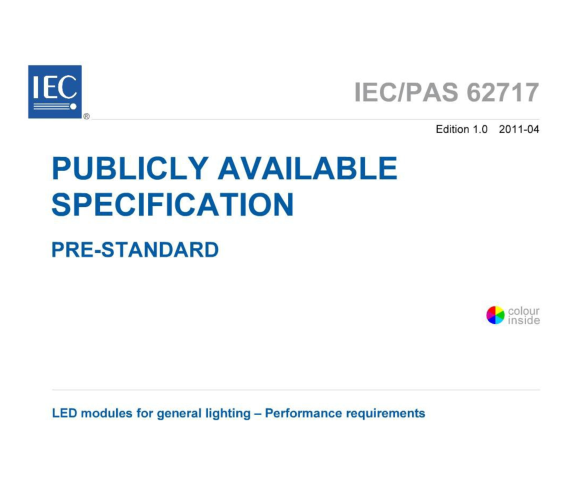IEC PAS62717:2011 pdfダウンロード

IEC PAS62717:2011 pdfダウンロード。LED modules for general lighting- Performance requirements
This PAS specifies the performance requirements for LED modules,together with the testmethods and conditions, required to show compliance with this PAS.
The following types of LED modules are distinguished (see Figure 1):
– Type 1: Self-ballasted LED modules for use on d.c. supplies up to 250 v or on a.c.
supplies up to 1 000 V at 50 Hz or 60 Hz;
Type 2: LED modules operating with external controlgear connected to the mains voltage,and having further control means inside (“semi-ballasted”) for operation under constantvoltage, constant, current or constant power;
Type 3: LED modules where the complete controlgear is separate from the module foroperation under constant voltage,constant current or constant power.
The power supply of the controlgear for semi-ballasted LED modules (Type 2) is an electronic device capable ofcontrolling currents, voltage or power within design limits.
The control unit of the controlgear for semi-ballasted LED modules (Type 2) is an electronic device to control theelectrical energy to the LED’s.
A LED module with external controlgear can be either a non-ballasted LED module or a semi-ballasted LEDmodule.Figure 1 – Types of LED modulesThe requirements of this PAS relate only to type testing.Recommendations for whole product testing or batch testing are under consideration.This PAS covers LED modules that intentionally produce white light, based on inorganicLEDs.
These performance requirements are additional to the requirements in IEC 62031 safetystandard for LED modules.
Life time of LED modules is in most cases much longer than the practical test timesConseauently, verification of manufacturer’s life time claims cannot be made in a sufficientlconfident way, because projecting test data further in time is not standardised. For thatreason, the acceptance or rejection of a manufacturers life time claim, past 25 % of rated life(with a maximum of 6 000 h),is out of the scope of this PAS.
Instead of life time validation, this PAS has opted for lumen maintenance codes at a definedfinite test time. Therefore, the code number does not imply a prediction of achievable life time.The categories are lumen-depreciation character categories showing behaviour in agreementwith manufacturer’s information which are provided before the test is started.
In order to validate a life time claim, an extrapolation of test data is needed. A general methodof projecting measurement data beyond limited test time is under consideration.
The pass/fail criterion of the life time test as defined in this PAS is different from the life timemetrics claimed by manufacturers. For explanation of recommended life time metrics, seeAnnex C.
NOTE 1 When modules are operated in a luminaire, the claimed performance data can deviate from the valuesestablished via this PAS due to e.g. luminaire components that impact the performance of the module.
NOTE 2 The external electronic controlgears for LED modules as mentioned in Type 2 and Type 3 are not part ofthe testing against the requirements of this PAS
NOTE 3 For protection for water and dust ingress, see Clause B.4.
It may be expected that self-ballasted LED modules which comply with this PAS will start andoperate satisfactorily at voltages between 92 % and 106 % of rated supply voltage. LEDmodules with external controlgear are expected to start and operate satisfactorily incombination with the specified controlgear complving with IEC 61347-2-13 and IEC 62384. AlLED modules are expected to start and operate satisfactorily when operated under theconditions specified by the module manufacturer and in a luminaire complying withIEC60598-1.
For compliance with EMC requirements, reference is made to regional requirements. Forrelevant standards,see Bibliography.
NOTE It should be regarded that only those types of LED modules are subject to EMC requirements whichin case of harmonic current are directly connected to the mains and have active elements on board;-in case of radiated or conducted disturbances are directly connected to the mains (Type 1) or to a battery
- Previous:IEC PAS 62633:2009 pdfダウンロード
- Next:IEC TR 60649:2007 pdfダウンロード